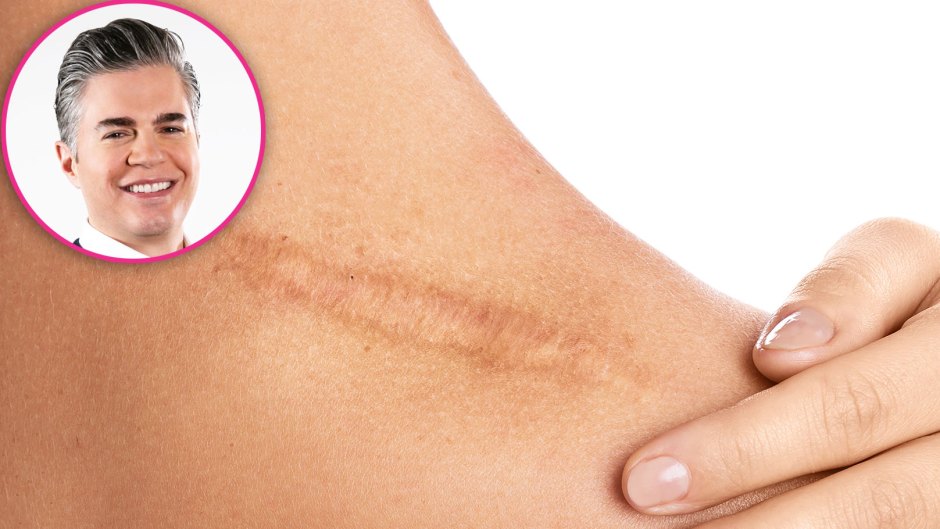
Shutterstock; Courtesy of Dr. Will Kirby (inset)
How to Reduce and Lighten Scars, According to Aesthetic Experts
Welcome to your skin check-in with Life & Style’s resident health and beauty expert, Dr. Will Kirby, a celebrity dermatologist and Chief Medical Officer of LaserAway. Every week, he’ll be spilling his candid thoughts and professional advice on all things skin, beauty and wellness as it relates to you — and your favorite stars.
There is ample confusion about the best ways to reduce the appearance and lighten the color of unsightly scars because there are so many different types of scars. And when there are many ways to treat a medical condition it’s because there isn’t just one single best way. This week, I reached out to the nation’s leading aesthetic experts to discuss scar treatment, reduction and lightening.
But before we get their recommendations, let’s have a brief review of the different types of scars and skin texture changes we we most commonly see.
Types of Scars
Regular scar: Scars can be caused by accidents, disease, surgery or minimally invasive aesthetic treatments, and nearly any time the skin is damaged a scar will form. Scar formation is part of the natural healing process as the body produces new collagen fibers at the site of the wound. Multiple factors come into play when discussing scar formation including the location of the wound, the patient’s age and the depth of the injury. Many scars can improve on their own over six to 18 months.
Hypertrophic scars: These types of scars occur when excessive amounts of collagen form at the site of injury. It won’t extend over the border of the injury but they may be raised, itchy and painful.
Keloid Scar: These scars present as fibrous tissue outgrowths. They are always raised and may be discolored, itchy and painful.
Contracture Scar: These scars can restrict movement and can occur when there is tissue loss, as in the case of a burn. They often present as a tightening of the skin.
Acne Scar: Scars can occur with acne and there are a number of different types of acne scars. The key to treating them is to first ensure that the active acne is being properly controlled.
Tissue Texture Change: Any time a superficial wound heals, you may have a minor surface irregularity. These types of changes usually continue to improve over time.
Discolored Scar: Any type of scar can have discoloration. The colors we usually see in scars include red, pink, brown and even sometimes white.
Now that we know the types of scars there are, let’s find out what our experts think!
How to Reduce and Lighten Scars
Facial cosmetic surgeon Dr. Alexander Rivkin notes, “We are treating self harm wounds with steroid injections to flatten raised scars, fillers to smooth depressed scars, and lasers to decrease red scars. We even offer scar treatment for free for patients in financial need!”
“One of the best things you can do to help soften, as well as lighten any scar, is to massage it multiple times a day,” remarks dermatologist Dr. Shaheen Khosla. “Use petroleum jelly, sunflower oil, or your favorite moisturizer. Massaging stimulates collagen and elastin to help with wound healing!”
“I have all of my patients massage their scars,” says plastic surgeon Dr. Gaurav Bharti. “This helps the collagen reorganize and ultimately leads to a flatter scar. In some certain cases I will also use a CO2 laser to help blend the scar into the background of adjacent skin.”
“The best way to reduce or lighten scars, bar none, is to use a quality topical silicone product with sunscreen in it,” says dermatologist Dr. Matt Elias. “We love topical silicones with SPF and recommend that all of our scar patients use them regularly. These products occlude and hydrate the skin promoting normal collagen and both preventing new scars and improving old scars.”
Dr. Lisa Grunebaum, a facial plastic surgeon, says, “I focus on scar minimization every day! My favorite scar treatment is hands down fractional erbium yag. I can use high settings with minimal down time to virtually disappear scars after one or more treatments. Lasers are definitely the way to go for many post-surgical scar treatments!”
“Topical products coupled with patient education and an appropriate timeline work wonders for many scars,” advises aesthetic nurse Corey Ordoyne. “I recommend Scar Recovery Gel with Centelline from Skin Medica. It absolutely helps minimize the appearance of scars!”
Dermatologist Dr. Curtus Asbury adds, “The best time to treat scars is when they are fresh! Once the wound is healed over and not oozing, I have my patients cut silicone scar sheets to the size of the scar and wear it for at least 12 hours a day. They really work!”
“Fraxel Dual from Solta is my go to laser for scars,” says dermatologist Dr. Deanne Mraz Robinson. “I love using both wavelengths to deeply penetrate into the skin to lessen scars while also treating more superficially to lighten them. It is a winning combo for scars!”
“For dark, hyperpigmented scars ,I typically recommend a non-hydroquinone, non-retinol formula like Even Tone Correcting Serum from Skinbetter Science,” aesthetic industry powerhouse Megan Driscoll says. “The serum blends skin brighteners and botanical ingredients, like kakadu plum and artemisia flower extracts, to reduce the look of pigment, sun damage, redness and yellowish discoloration that can occur in sun damaged skin!”
So there you have it! The experts have spoken! The truth is that some scars will never disappear completely, but they can usually be significantly reduced and the color in scars can be minimized or vanish with enough patience, time and the right care!




























![Zendaya Goes Braless in Deep Plunging Neon Dress for Challengers Event [Photos]](https://www.lifeandstylemag.com/wp-content/uploads/2024/04/Zendaya-Goes-Braless-in-Deep-Plunging-Neon-Dress-for-Challengers-Event-06.jpeg?crop=0px%2C332px%2C2520px%2C2520px&resize=300%2C300&quality=86&strip=all)
![Zendaya Goes Braless in Deep Plunging Neon Dress for Challengers Event [Photos]](https://www.lifeandstylemag.com/wp-content/uploads/2024/04/Zendaya-Goes-Braless-in-Deep-Plunging-Neon-Dress-for-Challengers-Event-06.jpeg?crop=0px%2C346px%2C2520px%2C1428px&resize=408%2C230&quality=86&strip=all)









